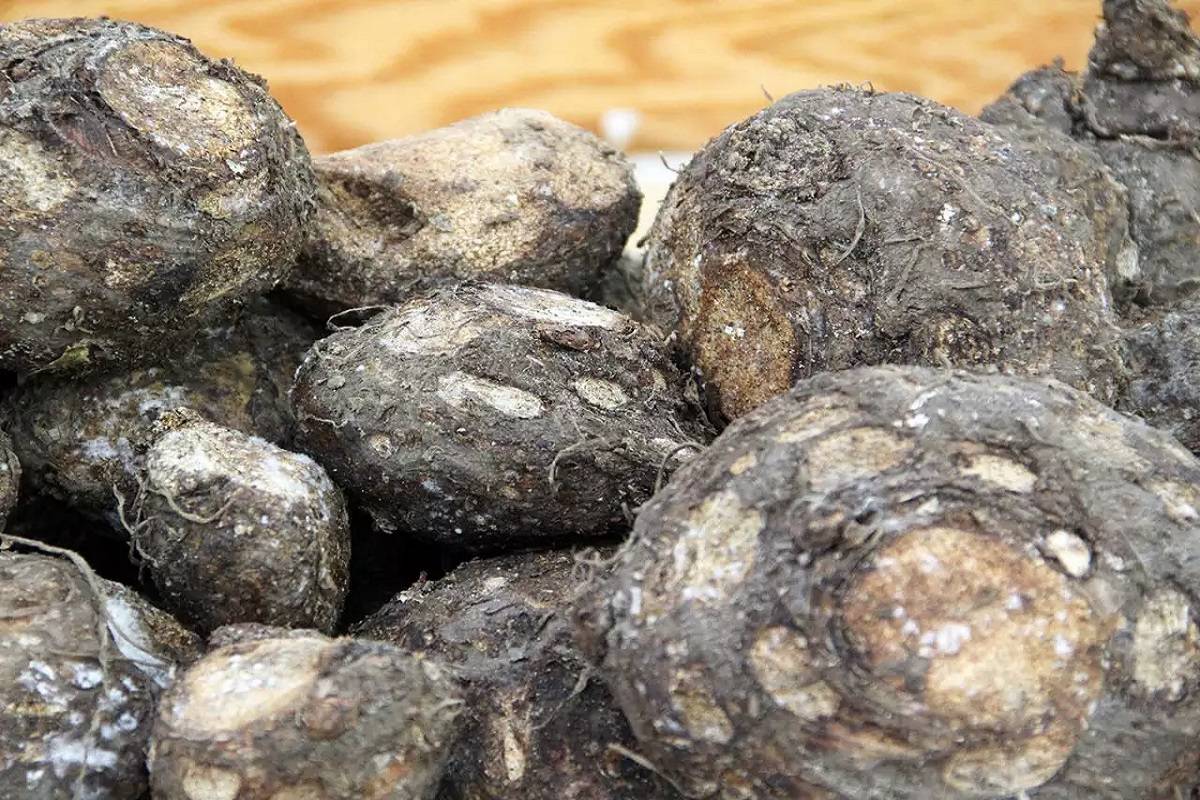
Amorphophallus paeoniifolius or elephant foot yam is also known as white spot giant arum in many places. Elephant foot yam is a popular tropical tuber crop that is used as a vegetable in various cuisines. In India, elephant foot yam is known by several different names. For instance, in West Bengal and Assam, elephant foot yam is pickled, mashed, fried, and even added to curries.
In Tripura, it is known as Batema and it is used to make buns that are eaten with fresh garlic or dried shrimp paste. Elephant foot yam is known as kaaraa karanai kizangu in Tamil Nadu and is either steamed or used to make chutney that is served as a side dish with rice. Elephant foot yam is also a popular ingredient in the three major Indian medical systems: Ayurveda, Siddha, and Unani. According to these medical systems, elephant foot yam is useful in the treatment of piles.
Nutritional Information
The nutritional value of elephant foot yam per 100 grams is as follows- 116 calories, 8 mg Sodium, 670 mg Potassium, 3% iron, 50 mg Calcium, 0.04 g of Protein, and 22 IU of Vitamin A. Elephant foot yam is an outstanding source of fibre, magnesium, and micronutrients such as copper and Vitamin C. It is also a good source of Vitamin B6, riboflavin, niacin, beta carotene, Vitamin B1, and folic acid.
Health Benefits of Elephant Foot Yam
Improves brain function- Elephant foot yam is rich in a unique compound called diosgenin, which is associated with promoting neuron growth and enhances brain function. Diosgenin consumption is also linked with improving the memory and learning abilities of mice.
Lowers inflammation- Elephant foot yam is rich in antioxidants that reduce inflammation caused by diabetes, cardiac issues, and obesity. According to a study conducted on rats, elephant foot yam also lowers inflammation associated with ailments such as stomach ulcers, colon cancer, and irritable bowel syndrome.
Regulates cholesterol- Elephant foot yam, which has Omega-3 fatty acids, lowers the level of bad cholesterol in the body, whilst simultaneously reducing the levels of low and very low-density lipoproteins.
Reduces joint pain- In Ayurveda, elephant foot yam is applied to swollen joints after being mixed with ghee for immediate relief from pain.
Treats piles- Elephant foot yam is also used to treat piles in Ayurveda. Dried powder of elephant foot is consumed with buttermilk as a treatment for piles.
Hormonal balance in women- Elephant foot yam regulates the secretion of estrogen which ensures hormonal balance in women. Study shows that it also alleviates the symptoms of menopause as it increases the levels of estrone and estradiol, two hormones that typically decrease during menopause.
Anti-ageing properties- Elephant foot yam is rich in Vitamin C and helps cure premature ageing by slowing down the process of ageing and reducing blemishes and fine lines.
Improves digestive functioning- Elephant foot yam is known for its detoxifying properties which help clean pathogens and toxins from internal organs such as the liver, small and large intestines, and stomach. Plus, because elephant foot yam is rich in fibre and low in calories, it is an excellent vegetable for people who wish to lose weight.
Alleviates stress- Elephant foot yam is rich in carbohydrates, protein, vitamin A, potassium, and iron. By consuming this vegetable, we give our body ample energy to deal with our day-to-day activities, and this improves our mood and in turn alleviates stress.
Cures Haemorrhoids- If you suffer from haemorrhoids then you should make elephant foot yam a staple of your diet because it can cure them.
Conclusion
Elephant foot yam is in many ways the perfect vegetable because it is not only tasty but also has a lot of health benefits. It is jam-packed with vitamins, minerals, antioxidants, and fibres, It is a truly magical vegetable that reduces the symptoms of diabetes, controls cholesterol, helps lose weight, and improves the metabolic process.
















